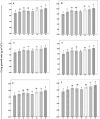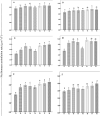Seed priming with selenium and zinc nanoparticles modifies germination, growth, and yield of direct-seeded rice (Oryza sativa L.)
- PMID: 35501374
- PMCID: PMC9061837
- DOI: 10.1038/s41598-022-11307-4
Seed priming with selenium and zinc nanoparticles modifies germination, growth, and yield of direct-seeded rice (Oryza sativa L.)
Abstract
Direct-seeded rice (DSR) seeds are often exposed to multiple environmental stresses in the field, leading to poor emergence, growth and productivity. Appropriate seed priming agents may help to overcome these challenges by ensuring uniform seed germination, and better seedling stand establishment. To examine the effectiveness of sodium selenite (Na-selenite), sodium selenate (Na-selenate), zinc oxide nanoparticles (ZnO-NPs), and their combinations as priming agents for DSR seeds, a controlled pot experiment followed by a field experiment over two consecutive years was conducted on a sandy clay loam soil (Inceptisol) in West Bengal, India. Priming with combinations of all priming agents had advantages over the hydro-priming treatment (control). All the combinations of the three priming agents resulted in the early emergence of seedlings with improved vigour. In the field experiment, all the combinations increased the plant chlorophyll, phenol and protein contents, leaf area index and duration, crop growth rate, uptake of nutrients (N, P, K, B, Zn and Si), and yield of DSR over the control. Our findings suggest that seed priming with the combination of ZnO-NPs, Na-selenite, and Na-selenate could be a viable option for the risk mitigation in DSR.
© 2022. The Author(s).
Conflict of interest statement
The authors declare no competing interests.
Figures




References
Publication types
MeSH terms
Substances
LinkOut - more resources
Full Text Sources

